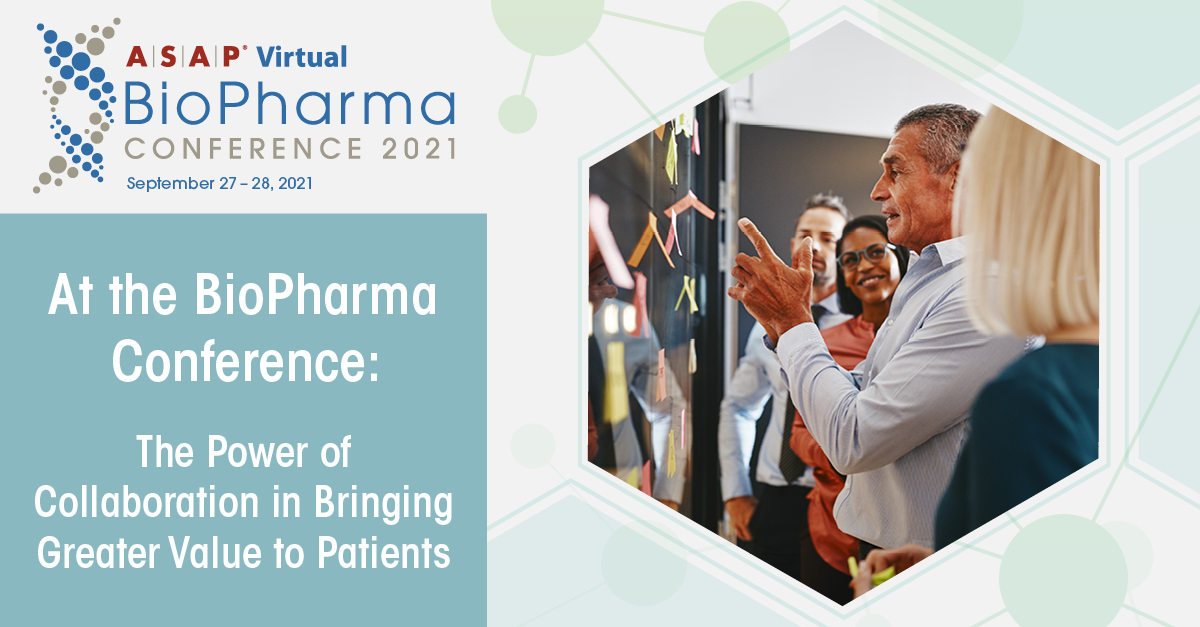Biopharma Alliance Management Leads the Way—to What the Patient Needs
Day one of the 2021 ASAP BioPharma Conference was replete with mentions of two key elements: collaboration and patient-centricity. Neither one is an unusual feature of biopharma alliances—and both are embraced in the conference theme this year, “Mastering the Biopharma Ecosystem to Cocreate New Value and Better Patient Outcomes”—but given advances in technology, the impact of COVID-19, and trends such as precision medicine, AI, and real world data, change has come to both areas.
Collaborations and clinical trials have both become more challenging in a remote world, for example, but these challenges have spurred on new ways and alternative methods of getting them done. Many biopharma organizations, meanwhile, have sought to provide patients with greater flexibility and optionality in treatments and trials alike.
Thus the patient has often (if not always) been at the center of biopharma efforts, but as one conference panelist asked: How do we keep patient-centricity from just "becoming a tagline”? And how can alliance professionals do all the right things to keep collaborations moving forward productively while still keeping an eye on unmet patient needs?
“Patients Are Waiting”
Those were among the questions touched on throughout the day, notably kicked off by the keynote presentation, “The Power of Collaboration in Bringing Greater Value to Patients,” by Helen Torley, CEO and board member of Halozyme, and Tim Van Hauwermeiren, CEO and cofounder of argenx.
Halozyme is a relatively small company (about 140 employees) based in San Diego that currently has 11 partners and five approved products so far for its Enhanze technology, which uses subcutaneous injection for certain drugs—thus saving time and in some cases avoiding hospital or clinic visits, since it allows for self-administration of treatments at home. The goal? To “improve the patient experience,” according to Torley.
argenx is a larger company (around 850 employees) with offices in Boston, Ghent (Belgium), Geneva, and Tokyo. Its autoimmune disease drug candidate efgartigimod is involved in six trials this year, and argenx has partnered with Halozyme to utilize its Enhanze technology—again, to better and more efficiently meet the needs of patients.
“Both of our companies wanted to move fast,” said Van Hauwermeiren. “We felt a sense of urgency because patients are waiting.”
Driving the Agenda and Navigating Stormy Seas
Van Hauwermeiren, who in the past worked for consumer goods giant Procter & Gamble, said he was surprised on entering the biopharma industry in the early 2000s to find that “the patient was not always central to the thinking.” But that mindset is rapidly changing, and the argenx-Halozyme collaboration is part of the trend. Because it’s faster and easier than an IV, subcutaneous injection may work better for younger, more active patients, and avoids the COVID risks of spending time in hospital or clinic waiting rooms.
In other words, it’s a win-win.
As for the collaboration itself, Torley said it’s based on openness, transparency, information sharing, trust, and shared goals. And while it’s great when the two CEOs get along well, the real work on this front is of course done largely by alliance professionals.
At the C-level, Torley said, “We’re talking business, strategy—we don’t have to talk about the alliance. We don’t have to get involved operationally.”
“A good alliance leader is driving the common strategic agenda between both parties,” Van Hauwermeiren added. “It’s a very important job—and it’s a function that flows right into the C-suite.”
Torley noted that even in the best collaborations, there will always be a need to “solve [for] the inevitable small barriers,” and this is also where alliance management—and more to the point, alliance leadership—comes in. “Great alliance leadership sometimes has to help navigate through some pretty stormy waters,” she acknowledged. “Alliance leadership leads the way in understanding what the partner needs.”
And in the end, that helps both partners—and all parties—keep the focus on what the patient needs as well.
Stay tuned to this space for more coverage of the 2021 ASAP BioPharma Conference, and visit asapbiopharma.org for more information or to register so you can catch the second day of programming plus all the great on-demand sessions and archived livestream presentations.

